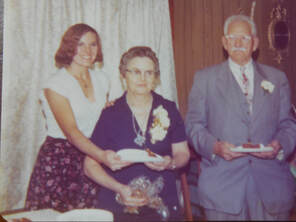Grandma Evelyn Louise Verplank, my maternal grandmother, married Franz (Frank) Johan Reikofski on October 20, 1926. They lived in Buffalo Creek, Tilden, and Neligh, Nebraska. Her grandparents came from Iowa in a covered wagon and settled at Buffalo Creek. Grandma didn’t talk much, but Grandpa told me about both their families. She was one of twelve children.
Great-Grandma Bertha Verplank’s hair was the color of metal which she wore in braids wound on each side of her head. She also sported warts on the end of her nose and chin, with no teeth in her mouth, those hairy warts almost touched when she closed her mouth to chew or talk. Unlike the witches of Grimm’s Fairy Tales, she was a wonderful woman. Like her daughter, she was a quiet woman who held her feelings and thoughts inside, probably due to a rough life.
Great-Grandma Bertha Augusta Vollbrecht Reikosfki, also gave birth to twelve children. She was born in Schoenwald, Germany. We called her Little Grandma because she was so short that she stood on a box to wash dishes at a café in Tilden. Her hair was long enough to sit on. In her last years, she lived with my grandparents and Grandma braided Little Grandma’s hair, then coiled it on the back of her head.
My mother’s mother answered my questions, but didn’t really talk to me. She was shorter than me, and appeared old in her early forties. She worked at Mac’s Café in downtown Neligh, as a maid in one of the motels, and her last job was housekeeping at the hospital. She wore pastel nylon uniforms at each place. At some point, Grandma taught me how to make hospital corners while putting clean sheets on a bed. Grandma could peel an apple without breaking the spiral. This is folklore handed down from her mother-in-law, Great-Grandma Reikofski. An unbroken peel thrown over the shoulder lands in a letter formation that reveals the initial of the one a single girl will marry. Pretty amazing, those stories Grandpa Reikofski told me. We watched her from a doorway or another room while he talked.
Grandma Reikofski drove a 1936 behemoth, a black Packard, to work and to the Methodist Church. When I see her in my mind’s eye, I picture her sitting at the oval oak table by the window in the front room, writing letters, or absorbed in True Story magazine (which she believed). I also picture her potted African violets in perpetual bloom, tinted white, lavender, and deep purple.
She knew sorrow when it came to burying her children. Uncle Raymond was killed at age ten, a couple blocks from their home in Neligh. While sledding down a hill, he met a farmer’s pickup in the intersection, and was decapitated. Her two oldest children, Uncle Harvey Dale, and then my mother, died tragically in their thirties and forties, respectively.
There were happy times as well. Grandma and Grandpa dressed up and went to Saturday night dances at Riverside in Norfolk. We often had family dinners at their home on Sundays. And they welcomed me the nights I stayed in town because I didn’t drive while in high school.


 RSS Feed
RSS Feed
